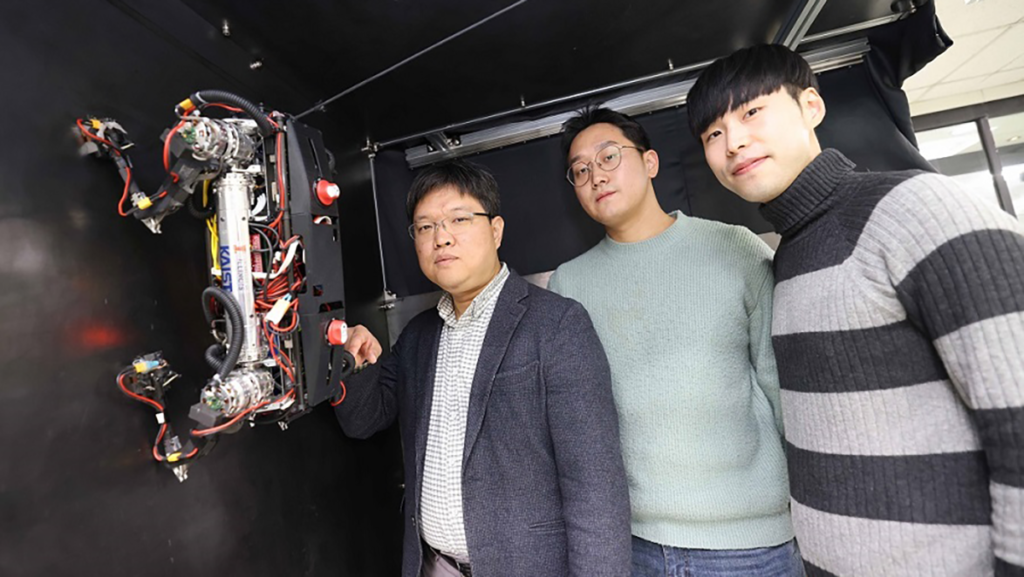KAIST Mechanics announced in December 2022 that a research team, led by Professor Hae-Won Park of the Department of Mechanical Engineering, developed a quadrupedal walking robot that can move at high speed on steel walls and ceilings named M.A.R.V.E.L.
M.A.R.V.E.L. is a “magnetically adhesive robot for versatile and expeditious locomotion” as described in their paper, ‘Agile and Versatile Climbing on Ferromagnetic Surfaces with a Quadrupedal Robot’.
To make this happen, Professor Park’s research team developed a foot pad that can quickly turn the magnetic adhesive force on and off whilst retaining high adhesive force, even on an uneven surface, through the use of the Electro-Permanent Magnet (EPM), a device that can magnetise and demagnetise an electromagnet with little power, and the Magneto-Rheological Elastomer (MRE), an elastic material made by mixing a magnetic response factor, such as iron powder, with an elastic material, such as rubber, which is mounted on a small quadrupedal robot which has been made in-house.
The walking robots are expected to have a wide variety of uses, including being programmed to perform inspections, repairs, and maintenance tasks on large structures made of steel, such as ships, bridges, transmission towers, large storage areas, and construction sites.
The study, in which Seungwoo Hong and Yong Um of the Department of Mechanical Engineering participated as a co-author, was published as the cover paper in the December issue of Science Robotics.
In order to enable fast movement of the walking robot, the sole of the foot must have strong adhesion force and be able to control the adhesion to quickly switch from sticking to the surface or to be off of it. In addition, it is necessary to maintain the adhesion force even on a rough or uneven surface.
To solve this problem, the research team used the EPM and MRE for the first time in designing the soles of walking robots. Unlike general electromagnets, the EPM has the advantage of requiring little energy to maintain the magnetic force. The research team proposed a new EPM with a rectangular structure arrangement, enabling faster switching while significantly lowering the voltage required for switching compared to existing electromagnets.
In addition, the team was able to increase the frictional force without significantly reducing the magnetic force of the sole by covering the sole with an MRE. The proposed sole weighs only 169g, but it provides a vertical gripping force of about *535 Newtons (N) and a frictional force of 445 N, which is sufficient gripping force for a quadrupedal robot weighing 8kg.
MARVEL climbed up a vertical wall at a rate of 70cm per second, and it was able to walk while hanging upside down from the ceiling at a rate of 50cm per second. This is the fastest for a walking, climbing robot. On an even surface that is painted, dirty, dusty and rust-tainted, the research team demonstrated the robot could still climb at a rate of 35cm per second – proving its performance in a real-world environment.
It was also demonstrated that the robot could switch from floor to wall and from wall to ceiling, and overcome 5cm high obstacles, protruding from walls, without difficulty.
One of the papers co-authors, a Ph.D. student, Yong Um of KAIST’s Department of Mechanical Engineering, said: “By the use of the magnetic soles made up of the EPM and MRE and the non-linear model predictive controller suitable for climbing, the robot can speedily move through a variety of ferromagnetic surfaces including walls and ceilings, not just level grounds. We believe this would become a cornerstone that will expand the mobility and the places of pedal-mobile robots can venture into.” He added, “These robots can be put into good use in executing dangerous and difficult tasks on steel structures in places like the shipbuilding yards.”
This research was carried out with support from the National Research Foundation of Korea’s Basic Research in Science & Engineering Programme for Mid-Career Researchers and Korea Shipbuilding & Offshore Engineering Co., Ltd.
*535N converted to kg is 54.5kg, and 445N is 45.4kg. In other words, even if an external force of up to 54.5kg in the vertical direction and up to 45.4kg in the horizontal direction is applied (or even if a corresponding weight is hung), the sole of the foot does not come off the steel plate.
For more, check out our news page. And don’t forget our sister site, Electronic Specifier. You can also visit our LinkedIn page here!
